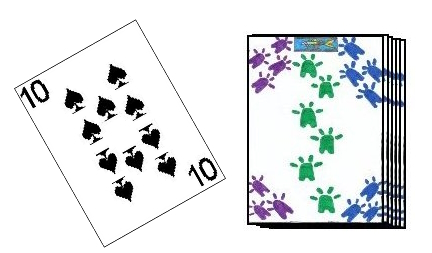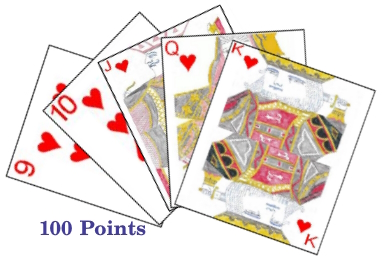Klaverjassen is a trick taking game which is highly popular in the Netherlands. In fact, the game is so popular there it is considered the National card of game of that country. Klaverjassen also commonly goes under the shortened name of Klaverjas. The game is played by four participants in two partnerships consisting of two players each.
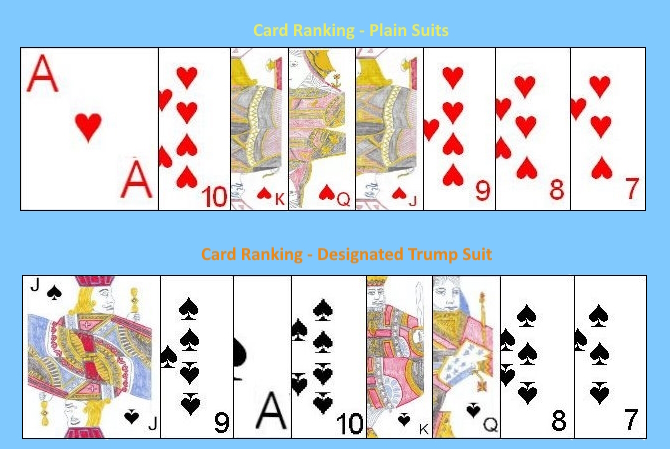 The game is traditionally played using the Swiss deck, which is similar to the standard French deck, however, in some cases the suits are different
(thus often containing the suits of Bells, Shields, Roses, and Acorns) and the court cards have differing names and markings
upon them. The King is often called Heer and is marked with an H, the Queen is known as the Vrouw and marked with a V and the Jack is called a Boer and marked with a B. Although often played with this Swiss deck, it can (and often is) played with a stripped down standard French deck which consists of 32 cards (consisting of one each of the cards from seven to Ace in each of the four suits). The ranking of the cards is different for the designated trump suits than that in the other three suits. For the trump suit (which will be determined after the deal of each hand), the ranking is as follows (from highest to lowest); Jack, 9, Ace, 10, King, Queen, 8, 7. In the non-trump suits (each of the other suits not designated as the trump suit for the hand), the ranking of the cards is as follows (from highest to lowest); Ace, 10, King, Queen, Jack, 9, 8, 7.
The game is traditionally played using the Swiss deck, which is similar to the standard French deck, however, in some cases the suits are different
(thus often containing the suits of Bells, Shields, Roses, and Acorns) and the court cards have differing names and markings
upon them. The King is often called Heer and is marked with an H, the Queen is known as the Vrouw and marked with a V and the Jack is called a Boer and marked with a B. Although often played with this Swiss deck, it can (and often is) played with a stripped down standard French deck which consists of 32 cards (consisting of one each of the cards from seven to Ace in each of the four suits). The ranking of the cards is different for the designated trump suits than that in the other three suits. For the trump suit (which will be determined after the deal of each hand), the ranking is as follows (from highest to lowest); Jack, 9, Ace, 10, King, Queen, 8, 7. In the non-trump suits (each of the other suits not designated as the trump suit for the hand), the ranking of the cards is as follows (from highest to lowest); Ace, 10, King, Queen, Jack, 9, 8, 7.
Determination of partnerships, and first dealer can be performed in a variety of ways, with a draw for high card one such method. Using that method, each would thus player draw a card from the face-down shuffled deck and the two players drawing the two highest cards would play as partners against the players drawing the two lowest cards. The player drawing the highest card of all is set as the first dealer. Thereafter the role of dealer rotates around the table in a clockwise direction. The dealer has the first choice of seats at the table and each player should sit directly across the table from their partner.
After the first dealer has been determined, the dealer thoroughly shuffles the cards and offers it to the player at his right for the cut. After the cut, the dealer then begins dealing the cards in small face down packets, starting with the player at his immediate left and continuing in a clockwise direction around the table. First he deals a packet of three such cards to each player, then a packet of two cards, and lastly another packet of three, such that each player receives a total of eight cards.
The players then pick up and examine their hand. The player to the immediate left of the dealer has the first opportunity to choose the trump suit for the hand, but may also elect to pass. If he elects to pass, the next player in a clockwise direction then has the opportunity to name a trump suit for the hand, or pass. This opportunity continues around the table until a player elects to select the trump suit for the hand. If the first three players in rotation all pass, the dealer then MUST choose a trump suit for the hand. In choosing the trump suit for the hand, this player then chooses one of the four suits as the trump suit to be used during the hand. The player who chooses the trump suit for the hand is called the Player. Note that there are also several other ways in which the trump suit can be chosen (although the option of free selection is the most common). Please see the Variations section below, which describes the other available options.
Once the trump suit has been selected, play of the hand then begins. The player to the immediate left of the dealer leads the first card to the first trick, and each other player in a clockwise direction then plays one card remaining in his hand to the same trick, until all four players have contributed one card to the trick.
The leader to a trick may play any card of choice from his hand to start the trick. Each other player, in turn then adds a card to the trick.
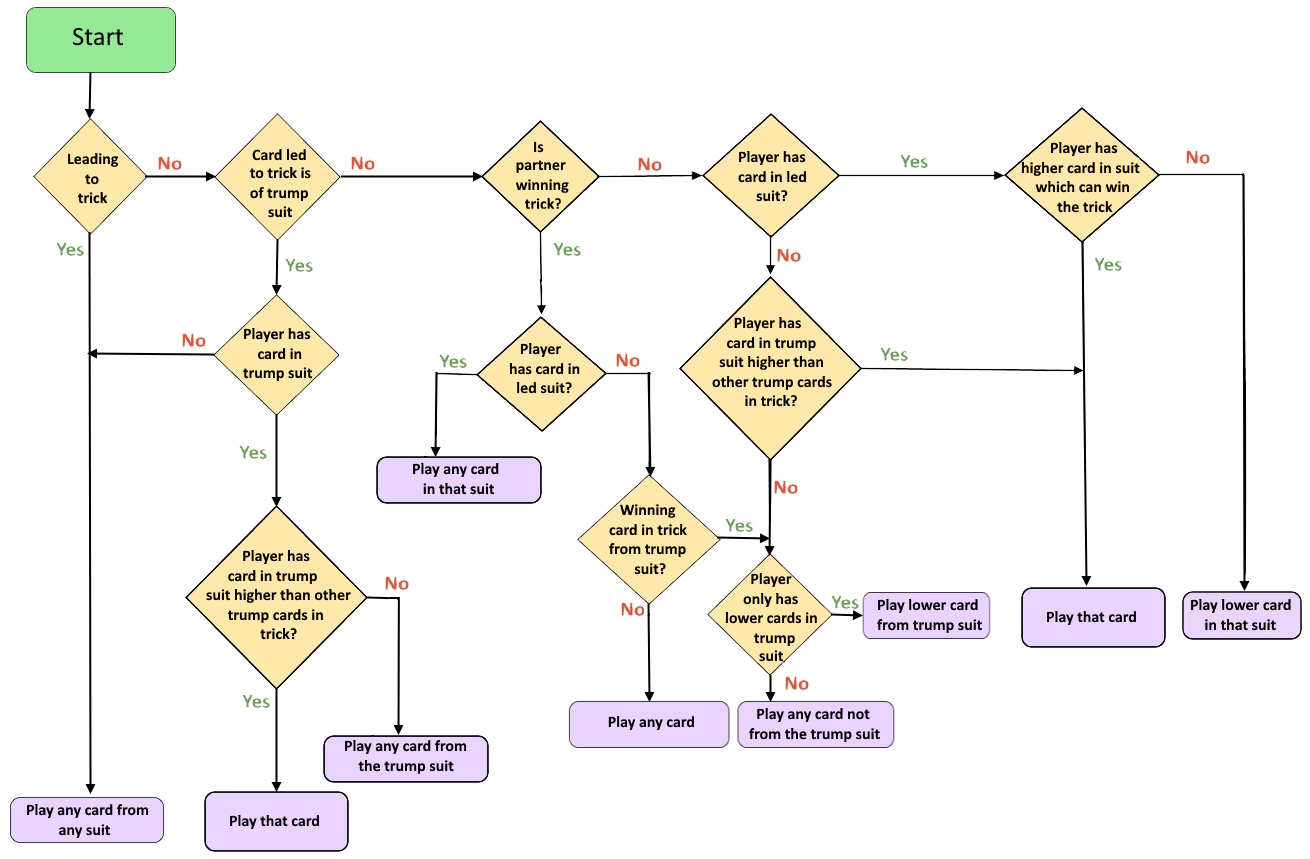 After the lead to a trick, the rules for following this lead are somewhat more strict than in many other trick-taking games. As normal, if a player has a card in the same suit as originally played to the trick he must play it, but if he multiple cards in that suit he has the choice of which he will play. However, if he has no cards in the suit originally led to the trick, and the trick (as per the cards currently found in the trick) is currently being won by a member of the opposing team, the player must attempt to win the trick if possible, playing a card in the trump suit. If the trick already contains a card from the trump suit (and is currently being won by a member of the opposition) the player must thus play a higher card from the trump suit than the highest
ranked card currently found in it. If the player has no higher cards in the trump suit, he must play a card not from the trump suit (unless he only has lower cards in the trump suit remaining in his hand). If the trick is being won by a card from the trump suit, a player has no cards from the trump suit, and that player's partner is currently winning the trick the player must play a card not in the trump suit (or may play a higher card from the trump suit), unless the only cards he has remaining in his hand are lower ranked cards from the trump suit.
After the lead to a trick, the rules for following this lead are somewhat more strict than in many other trick-taking games. As normal, if a player has a card in the same suit as originally played to the trick he must play it, but if he multiple cards in that suit he has the choice of which he will play. However, if he has no cards in the suit originally led to the trick, and the trick (as per the cards currently found in the trick) is currently being won by a member of the opposing team, the player must attempt to win the trick if possible, playing a card in the trump suit. If the trick already contains a card from the trump suit (and is currently being won by a member of the opposition) the player must thus play a higher card from the trump suit than the highest
ranked card currently found in it. If the player has no higher cards in the trump suit, he must play a card not from the trump suit (unless he only has lower cards in the trump suit remaining in his hand). If the trick is being won by a card from the trump suit, a player has no cards from the trump suit, and that player's partner is currently winning the trick the player must play a card not in the trump suit (or may play a higher card from the trump suit), unless the only cards he has remaining in his hand are lower ranked cards from the trump suit.
Similarly, if a player's partner is currently winning a trick which contains no cards from the trump suit, and the player has no cards in the suit originally led to the trick, he may play any card from his hand. If a card of the trump suit is led to the trick, each player must attempt to win the trick with a higher card in the trump suit if possible, regardless of whether the current player winning the trick is from the opposing partnership or not. If the player has no higher cards, they may play a lower one, and if they have no cards from the trump suit, they may play any other card from their hand.
After each player has played a card to the trick, using the rules above, it is determined which player has won the trick. The player of the highest trump card to the trick wins that trick if the trick contains any cards in that suit. However, if the trick contains no cards in the designated trump suit, the trick is won by the highest card of the suit originally led to the trick. The cards from that trick should then be set aside, face-down and out of play, for later scoring by the team winning that trick. The winner of each trick leads the first card to the next trick.
The object of the game is to collect the most points possible, which is particularly important for the team consisting of the player who decided the trump suit for the hand. The following are the various methods by which points can be scored during the hand:
- Each card captured in tricks has a corresponding scoring value, as per the following chart:
Card Scoring Value Jack of Trump Suit 20 Nine of Trump Suit 14 Ace of Any Suit 11 Each Ten of Any Suit 10 Each King of Any Suit 4 Each Queen of Any Suit 3 Each Jack of Non-Trump suit 2 each Nine of Non-Trump suit 0 8, 7 (of Any Suit) 0
- In addition to individual, point-scoring cards won in tricks, there are also points that can be scored for winning a trick which contains a specific point scoring combination in the trick (called roem). The sequential combinations do not need to be played a specific order during the trick, but all cards in that particular combination must be played within the same trick. The following are all such point-scoring combinations:
- Sequence (called a run) of four cards, all in the same suit - 50 Bonus Points
- Sequence (run) of three cards, all in the same suit - 20 Bonus Points
- Sequence of four cards (run), all in the trump suit, which also includes the King and Queen of the trump suit - 70 Bonus Points
- Sequence of three cards (run), all in the trump suit, which also includes the King and Queen of the trump same suit - 40 Bonus Points
- Four cards all of the exact same rank. These must be in the denomination of Ace, King, Queen, or ten - 100 Bonus Points
- Four Jacks - 200 Bonus Points
- King and Queen of the Trump Suit (Called Stuk) - 20 Bonus Points
- The team who wins the last trick earns 10 bonus points.
- If one team manages to win every trick during the hand, that team earns a bonus of 100 Points.
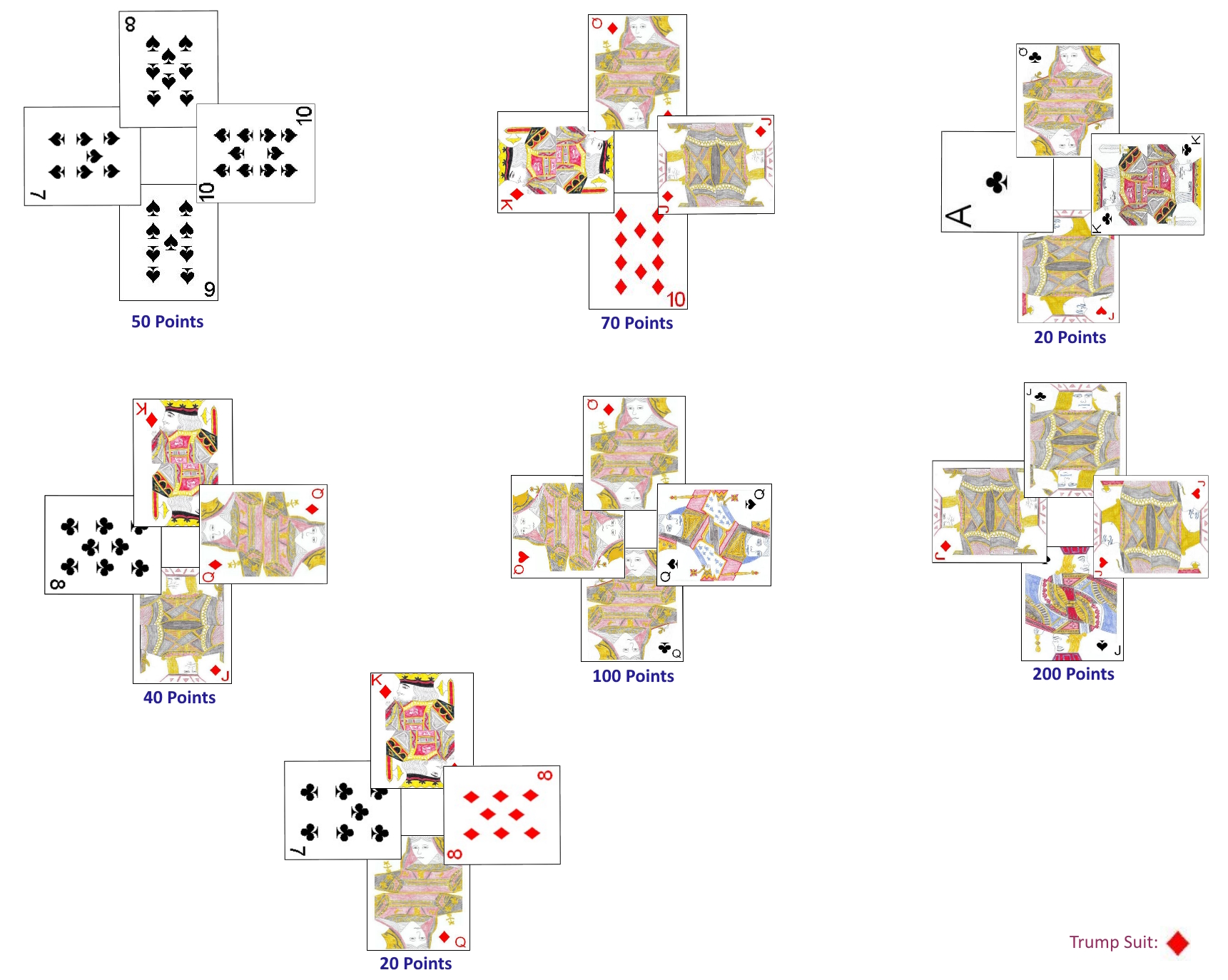
After all tricks have been played and won, scoring then occurs. Each team should add the total number of points earned during that hand (including the bonus points). If the team that set the trump suit for the hand earns more points than the opposing team during the hand, both teams earn an accumulated Game Point score equal to the number of points won during that hand. However, if the team who set the trump suit during the hand earns fewer or an equal number of points to the opposing team, the team which had declared the trump suit earns zero points for the hand, and the opposing team, earns a number of points equal to all points earned by both partnerships during that (hand including bonus points, which is the reason a team may decline bonus points during a hand). These earned points are added to an ongoing Game Point score for that partnership.
A full game session consists of exactly 16 hands. After these 16 hands have been completed, the team with the highest accumulated Game Point total is declared the winner of the entire game session.
Signaling: Players signaling to their partners is an accepted and expected part of the game in Klaverjassen. The signals used, however, which usually consist of how cards are played to a trick by a player, must be known and understood by all players, and thus should be clearly described and agreed upon before the start of play, to prevent any confusion during play. The following are some of the common schemes used:
- Same Suit Discards - This consists of a player using the play of particular cards in a suit to indicate a strength or weakness in that or another suit:
- If a player discards to a trick, a 7, 8 or 9, of a suit, the player can sometimes be using this as an indicator to his partner that he has the Ace of that same suit.
- Discarding a court card (King, Queen, or Jack) of a suit, the player might be signaling to his partner not to lead that same suit, if possible.
- Opposite Suit Discards - Using this scheme a player would discard a card of the same color but opposite suit of the suit he is attempting to convey information about.
- A player might thus, discard any card of a specific suit to indicate to his partner that he is strong in the opposite suit (alternate suit of the same color) to that discarded.
- Leading - This would be a signal by the player who selected the trump suit, indicating to his partner that he is weak, however, in the trump suit.
- If the player had the highest card in the trump suit, but no other cards or very low ones in the trump suit, he might lead a low card in another suit to indicate this.
- If the player has a high card, but not necessarily the highest card in the trump suit, but few other trump cards in the trump suit, he might lead an Ace of another suit.
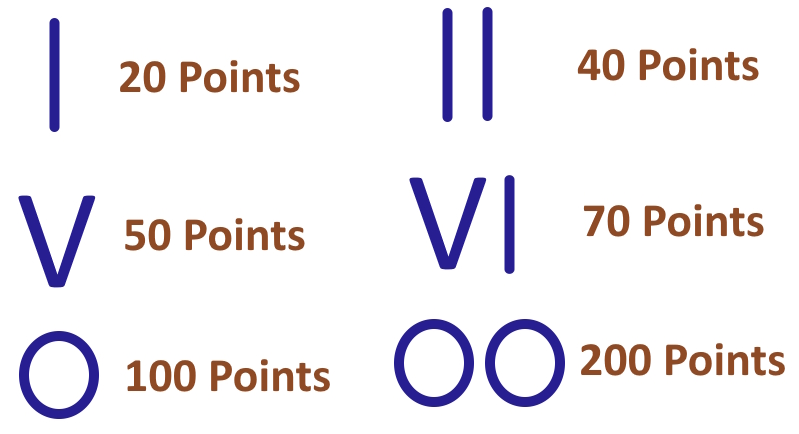 Scorekeeping: While the scores earned by a partnership for card points and the last trick are often recorded on their portion of the
score sheet using ordinary numerals, many players record most of the bonus points using special symbols. Using this
symbolic scoring 20 points would be represented by a |, 40 points by ||, 50 points with a V, 70 points with V|, 100 points with O, and 200 points with OO.
Scorekeeping: While the scores earned by a partnership for card points and the last trick are often recorded on their portion of the
score sheet using ordinary numerals, many players record most of the bonus points using special symbols. Using this
symbolic scoring 20 points would be represented by a |, 40 points by ||, 50 points with a V, 70 points with V|, 100 points with O, and 200 points with OO.
